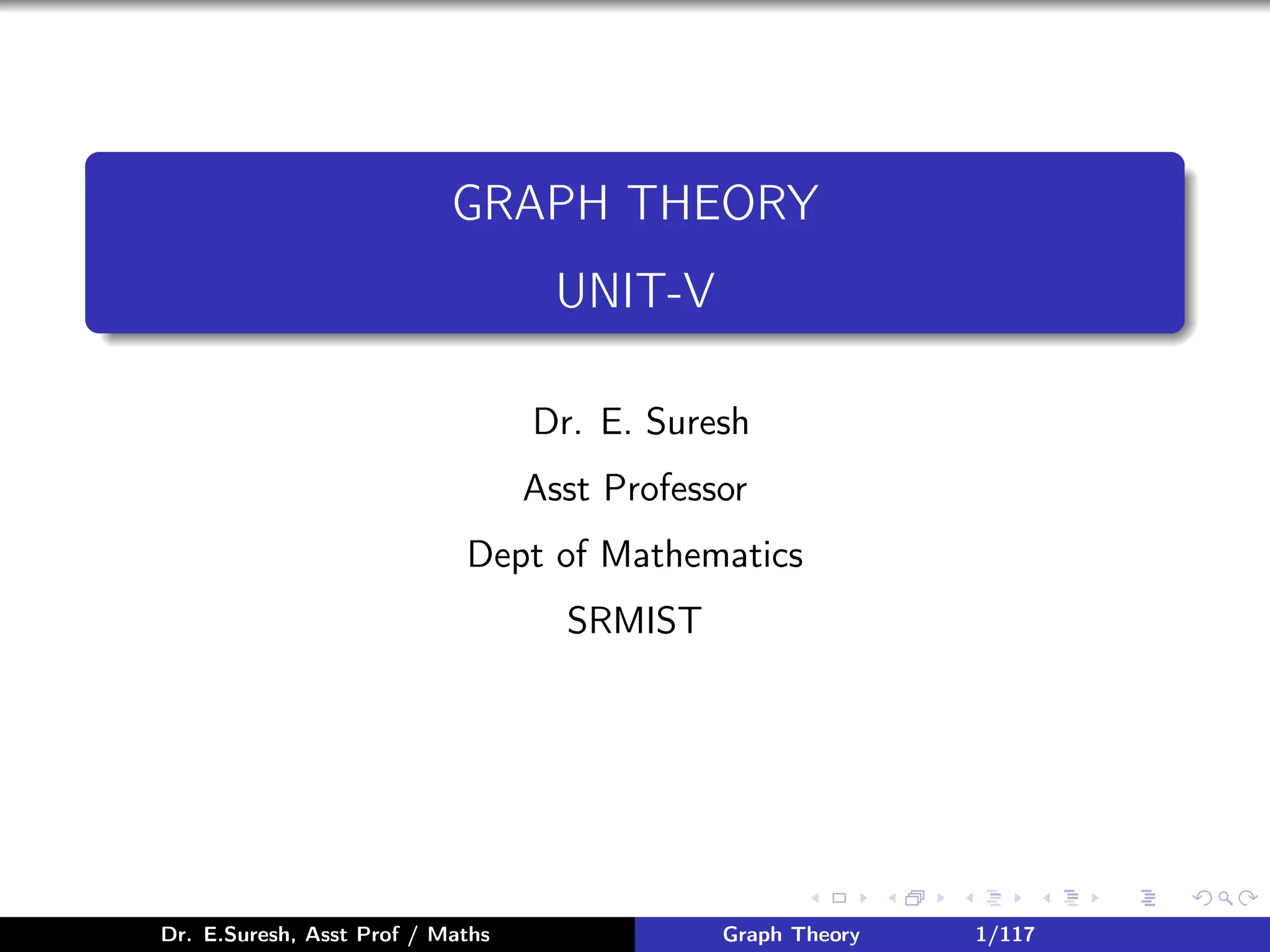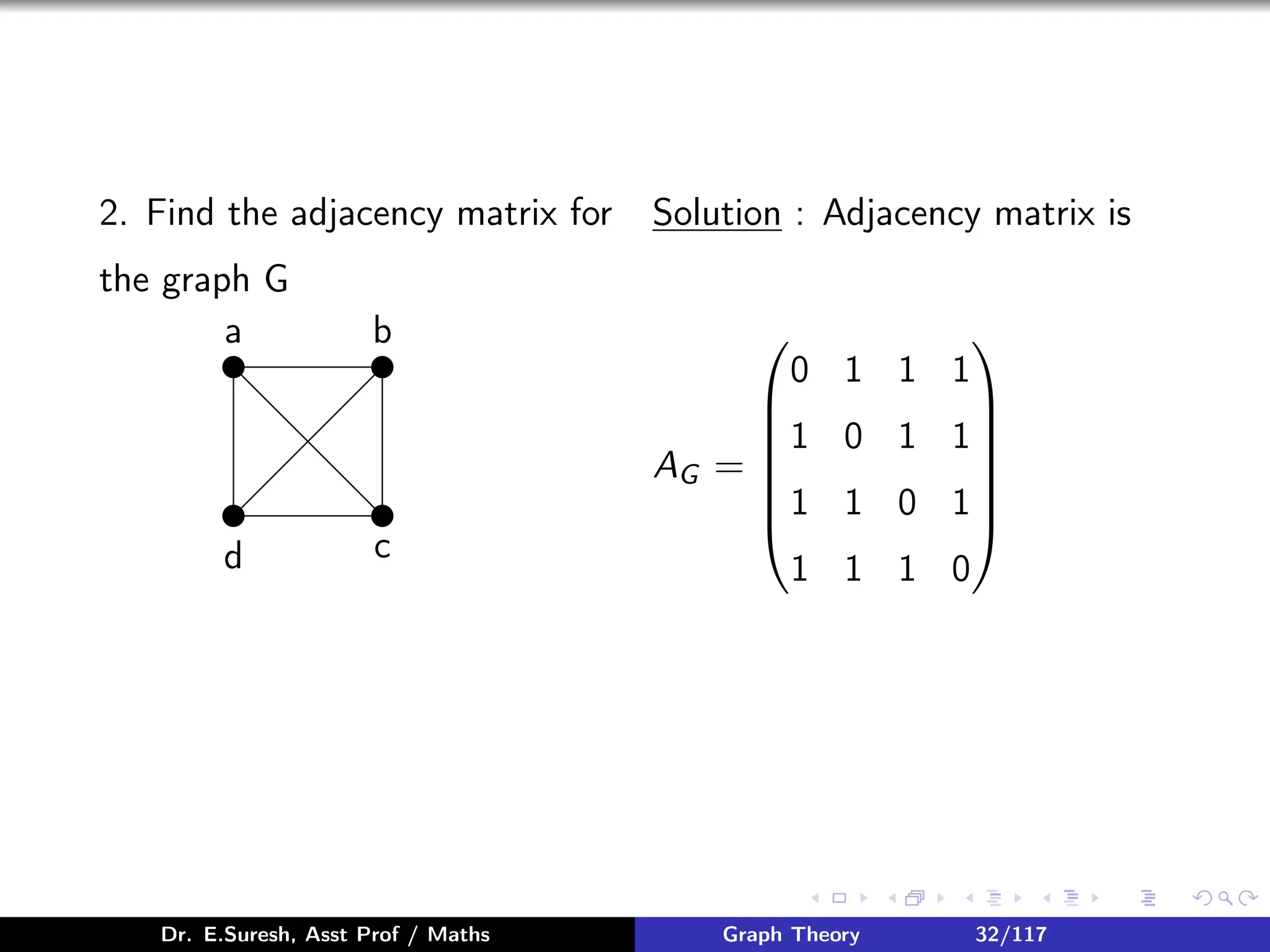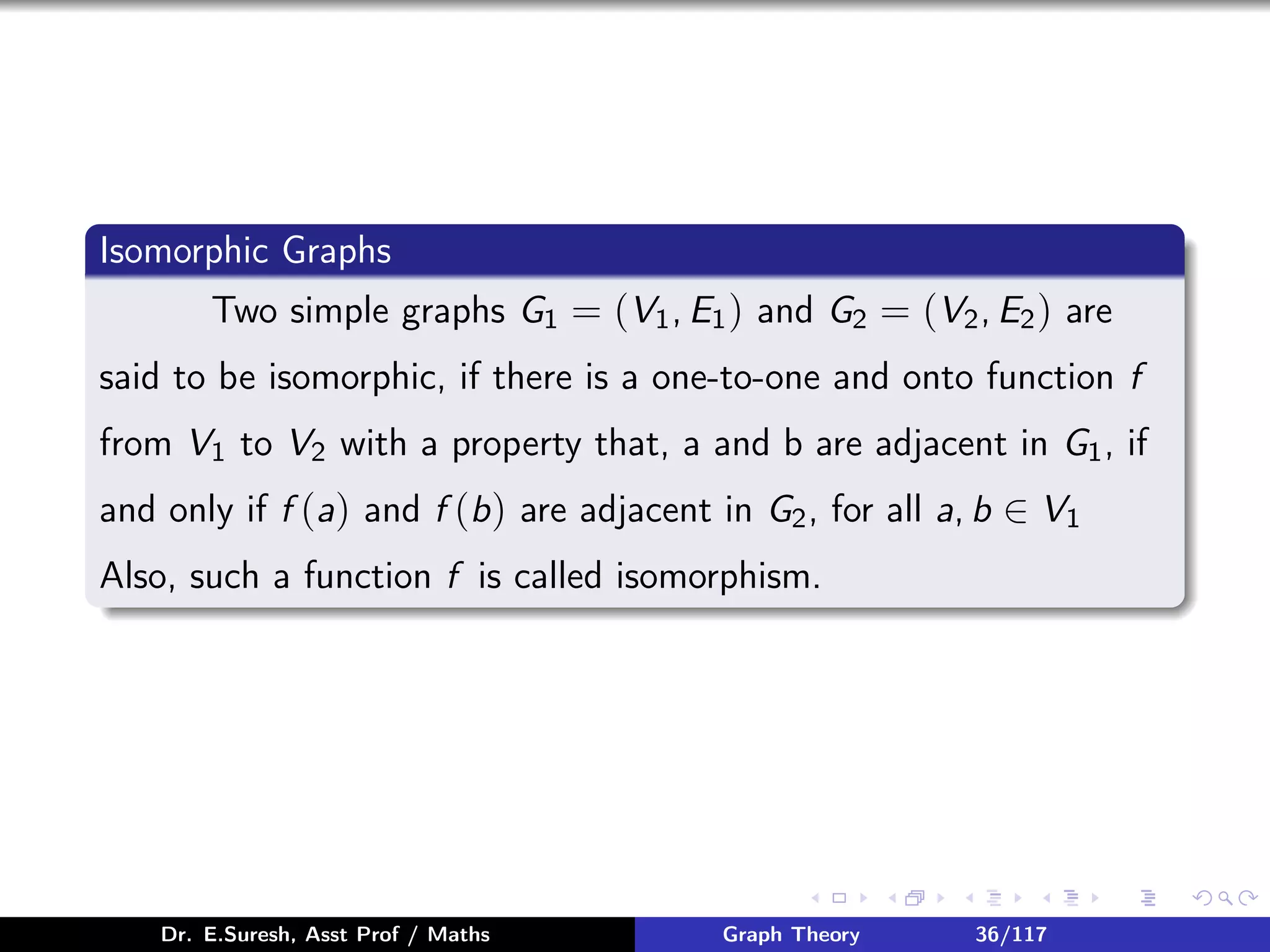The two graphs are isomorphic. They have:
1) Same number of vertices (4)
2) Same number of edges (5)
3) Same degree sequence (3, 2, 2, 1)
4) Corresponding vertices have the same degree
5) Corresponding adjacency matrices are the same
Therefore, the two graphs are isomorphic.


























![Matrix Representation of Graphs
Adjacency Matrix
If G = (V , E) is a simple graph with n vertices v1, v2, ...., vn, then
n × n matrix A of G, defined by
AG = [aij ], where aij =
1 if (vi , vj ) ∈ E(G)
0 otherwise
, is called the
Adjacency matrix of G
Dr. E.Suresh, Asst Prof / Maths Graph Theory 27/117](https://image.slidesharecdn.com/graph-theory-slides-221108134050-de2382f4/75/graph-theory-Slides-pdf-27-2048.jpg)

![Incident Matrix
If G = (V , E) is an undirected graph with n vertices v1, v2, ...., vn
and m edges e1, e2, ...., em then n × m matrix B = [bij ] where
bij =
1 if ej is incident with vi
0 otherwise
, is called the incident matrix
of G
Dr. E.Suresh, Asst Prof / Maths Graph Theory 29/117](https://image.slidesharecdn.com/graph-theory-slides-221108134050-de2382f4/75/graph-theory-Slides-pdf-29-2048.jpg)










































![Important Theorems
1 State and prove Handshaking theorem. Also prove that
maximum number of edges in a simple graph G with n vertices
is nC2 [or]
n(n−1)
2
Proof: Statement : Let G = (V , E) be a graph.
Then ∑
u∈V
deg(u) = 2 |E| where |E| is number of edges in G
proof:Consider an edge e = (u, v) of G
The edge e is incident with both end vertices u and v. The
contribution of e to each of the degrees of u and v is one.
Hence the total contribution of the edge e to sum of the
degrees of vertices of G is two.
Dr. E.Suresh, Asst Prof / Maths Graph Theory 72/117](https://image.slidesharecdn.com/graph-theory-slides-221108134050-de2382f4/75/graph-theory-Slides-pdf-72-2048.jpg)


![2 Prove that the number of vertices of odd degree in any graph
is even [OR]
Prove that undirected graph G has an even number of odd
degree vertices
Proof : Let G = (V , E) be an undirected graph
Let us split the vertex set V in to two disjoint subsets as
follows
V1 = Set of all odd degree vertices
V2 = Set of all even degree vertices
∴ V = V1 ∪ V2 and V1 ∩ V2 = φ
Dr. E.Suresh, Asst Prof / Maths Graph Theory 75/117](https://image.slidesharecdn.com/graph-theory-slides-221108134050-de2382f4/75/graph-theory-Slides-pdf-75-2048.jpg)



![3 If G is a self complementary graph, then prove that
G has n ≡ 0 or 1 (mod 4) [OR]
Show that the self complementary graph have 4n or 4n+1
vertices
Proof : Given G is a self complementary graph with n vertices
WKT G ∪ G = Kn
=⇒ |E(G)| + E(G) = n(n−1)
2 − − −− > (1)
Since G is self complementary, G u G
∴ |E(G)| = E(G)
Dr. E.Suresh, Asst Prof / Maths Graph Theory 79/117](https://image.slidesharecdn.com/graph-theory-slides-221108134050-de2382f4/75/graph-theory-Slides-pdf-79-2048.jpg)



![Examples of Path and Circuit/Cycle
a b
c d e
e1
e2
e5
e4
e3 e6
Path :
a − e1 − b − e4 − d − e5 − a − e2 − c − e3 − d − e6 − e
[OR] a − b − d − a − c − d − e
Simple Path : a − e1 − b − e4 − d − e6 − e [OR]
a − b − d − e
Simple Cycle : a − e1 − b − e4 − d − e5 − a
Simple Cycle : a − e1 − b − e4 − d − e3 − c − e2 − a
Dr. E.Suresh, Asst Prof / Maths Graph Theory 83/117](https://image.slidesharecdn.com/graph-theory-slides-221108134050-de2382f4/75/graph-theory-Slides-pdf-83-2048.jpg)













![We know that, maximum number of edges in ith component of
G is
ni (ni −1)
2
Therefore the maximum number of edges in G is
=
k
∑
i=1
ni (ni − 1)
2
=
1
2
k
∑
i=1
[ni
2
− ni ]
=
1
2
"
k
∑
i=1
ni
2
−
k
∑
i=1
ni
#
=
1
2
"
k
∑
i=1
ni
2
− n
#
− −− > (2) [By eqn (1) ]
Dr. E.Suresh, Asst Prof / Maths Graph Theory 97/117](https://image.slidesharecdn.com/graph-theory-slides-221108134050-de2382f4/75/graph-theory-Slides-pdf-97-2048.jpg)


![Substituting eqn(3) in eqn (2) we get,
∴ Maximum number of edges in G is
=
1
2
k
∑
i=1
ni
2
− n
#
≤
1
2
(n2
+ k2
− 2nk − k + 2n) − n
=
1
2
(n − k)2
− k + n
=
1
2
(n − k)2
+ (n − k)
=
1
2
[(n − k)(n − k + 1)]
=
(n − k)(n − k + 1)
2
Dr. E.Suresh, Asst Prof / Maths Graph Theory 100/117](https://image.slidesharecdn.com/graph-theory-slides-221108134050-de2382f4/75/graph-theory-Slides-pdf-100-2048.jpg)







![8 Prove that maximum number of edges in bi-partite graph with
n-vertices is n2
4 [OR]
Prove that the number of edges in a bi-partite graph with
n-vertices is atmost n2
4
Proof:Let the vertex set can be partitioned into two subsets V1
and V2. Let V1 contains x vertices, then V2 contains n − x
vertices. The maximum number of edges in the graph can be
obtained when each of x vertices in V1 is connected to each of
n − x vertices in V2
Dr. E.Suresh, Asst Prof / Maths Graph Theory 108/117](https://image.slidesharecdn.com/graph-theory-slides-221108134050-de2382f4/75/graph-theory-Slides-pdf-108-2048.jpg)








